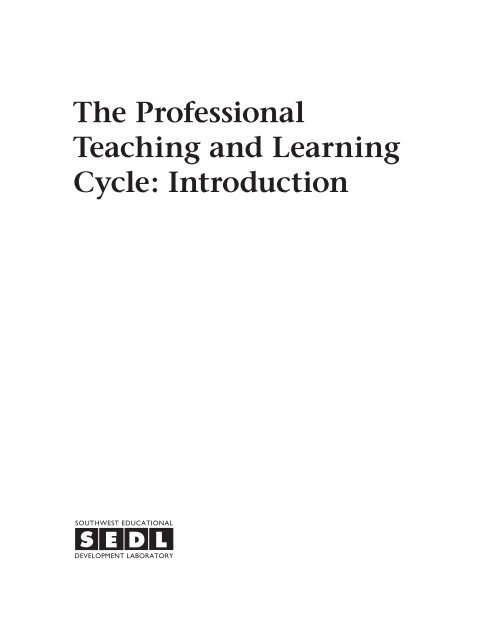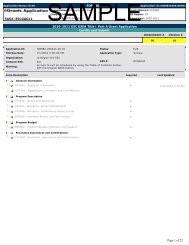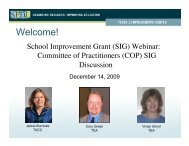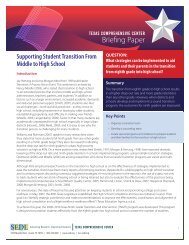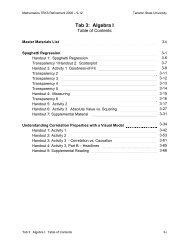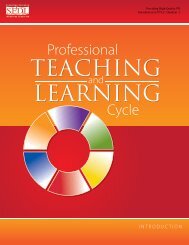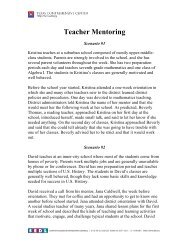The Professional Teaching and Learning Cycle: Introduction - Texas ...
The Professional Teaching and Learning Cycle: Introduction - Texas ...
The Professional Teaching and Learning Cycle: Introduction - Texas ...
Create successful ePaper yourself
Turn your PDF publications into a flip-book with our unique Google optimized e-Paper software.
<strong>The</strong> <strong>Professional</strong><br />
<strong>Teaching</strong> <strong>and</strong> <strong>Learning</strong><br />
<strong>Cycle</strong>: <strong>Introduction</strong>
SEDL<br />
4700 Mueller Blvd.<br />
Austin, TX 78723<br />
Phone 800-476-6861<br />
FAX 512-476-2286<br />
Web http://www.sedl.org/<br />
Copyright ©2005 by Southwest Educational Development Laboratory. This publication<br />
was produced in whole or in part with funds for the Institute of Education Sciences, U.S.<br />
Department of Education, under contract number ED-01-C0-0009. <strong>The</strong> content herein<br />
does not necessarily reflect the views of the U.S. Department of Education or any other<br />
agency of the U.S. government, nor does it reflect the views of any other source.<br />
- ii -
Acknowledgments<br />
This module is the culmination of intensive site work conducted by staff members of the<br />
Southwest Educational Development Laboratory <strong>and</strong> the Charles A. Dana Center at the<br />
University of <strong>Texas</strong> at Austin. <strong>The</strong>se individuals facilitated the Working Systemically process<br />
in classrooms, schools, <strong>and</strong> districts across the southwest region over a 5-year period. <strong>The</strong>y<br />
contributed invaluable expertise <strong>and</strong> a passion for school improvement throughout the<br />
duration of this work. As such, this product is not the work of one individual, but is instead<br />
representative of the work of many. SEDL staff, consultants, <strong>and</strong> myriad individuals who<br />
participated in this effort have all contributed to the development of these materials in so<br />
many ways that it would be impossible to recognize all of their contributions. We sincerely<br />
thank everyone who has shared his or her knowledge <strong>and</strong> expertise as a part of this effort<br />
to increase student achievement.<br />
Contributors<br />
• Stella Bell<br />
• Janice Bradley<br />
• D’Ette Cowan<br />
• W. David Hill<br />
• Ted Hull<br />
• Stacey Joyner<br />
• Tom McVey<br />
• Ann Neeley<br />
• Deborah Reed<br />
• Shae Small<br />
• William Sommers<br />
• Tara Leo Thompson<br />
• Ed Tobia<br />
• Emma Trevino<br />
• Judy Waisath<br />
• Sebastian Wren<br />
- iii -
Contents<br />
What Is the <strong>Professional</strong> <strong>Teaching</strong> <strong>and</strong> <strong>Learning</strong> <strong>Cycle</strong>? . . . . . . . . . . . . . . . . . 1<br />
<strong>The</strong> Six Steps of the <strong>Professional</strong> <strong>Teaching</strong> <strong>and</strong> <strong>Learning</strong> <strong>Cycle</strong> . . . . . . . . . . . . . . 3<br />
How to Begin . . . . . . . . . . . . . . . . . . . . . . . . . . . . . . . . . . . . . . . . . . . . . . . . . . . . . . 6<br />
Leadership <strong>and</strong> Support . . . . . . . . . . . . . . . . . . . . . . . . . . . . . . . . . . . . . . . . . . . . . . 7<br />
Culture . . . . . . . . . . . . . . . . . . . . . . . . . . . . . . . . . . . . . . . . . . . . . . . . . . . . . . . . . . . 8<br />
Summing Up . . . . . . . . . . . . . . . . . . . . . . . . . . . . . . . . . . . . . . . . . . . . . . . . . . . . . . 9<br />
References. . . . . . . . . . . . . . . . . . . . . . . . . . . . . . . . . . . . . . . . . . . . . . . . . . . . . . . . 10<br />
- -
What Is the <strong>Professional</strong> <strong>Teaching</strong><br />
<strong>and</strong> <strong>Learning</strong> <strong>Cycle</strong>?<br />
<strong>The</strong> professional teaching <strong>and</strong> learning cycle (PTLC) is a professional development process in<br />
which teachers collaboratively plan <strong>and</strong> implement lessons aligned to their state st<strong>and</strong>ards.<br />
This process is an important part of the Working Systemically approach, designed by SEDL to<br />
improve a school system’s capacity to increase student achievement. Working in partnership<br />
with the Charles A. Dana Center at the University of <strong>Texas</strong> at Austin, SEDL developed this<br />
job-embedded process that reflects the research on professional development <strong>and</strong> school<br />
improvement.<br />
PTLC is a critical component of the Working Systemically approach that directly impacts<br />
classroom instruction <strong>and</strong> student learning. It is a vehicle for teacher collaboration <strong>and</strong> sharing,<br />
<strong>and</strong> the process improves alignment of curriculum, instruction, <strong>and</strong> assessment to the state<br />
st<strong>and</strong>ards.<br />
PTLC is an ongoing, cyclic process that is designed to improve the<br />
• quality of professional development (ongoing, job-embedded, results-driven);<br />
• professional collaboration among staff;<br />
• use of data to inform instructional <strong>and</strong> programmatic decisions;<br />
• alignment of curriculum, instruction, <strong>and</strong> assessment to the state st<strong>and</strong>ards;<br />
• quality <strong>and</strong> coherence of instruction across classrooms;<br />
• monitoring of student learning; <strong>and</strong><br />
• leadership-support systems for continuous school improvement.<br />
Typically, interventions aimed at improving student achievement target only individual<br />
components of school improvement <strong>and</strong> professional development. A school improvement<br />
initiative might focus on improving alignment of the curriculum or on the collection <strong>and</strong><br />
use of data. <strong>The</strong>se interventions tend to result in marginal gains in student achievement,<br />
but little evidence suggests that those gains persist beyond the time of the intervention.<br />
PTLC, on the other h<strong>and</strong>, is designed to work systemically. It addresses teacher quality <strong>and</strong><br />
school improvement both collectively <strong>and</strong> holistically, thus increasing the likelihood that<br />
improvements will be sustained over time.<br />
PTLC is not a simple process, nor is it a “quick fix” for school improvement. A substantial<br />
amount of commitment <strong>and</strong> work is necessary to develop the process into a meaningful<br />
instructional improvement strategy. Once established, it becomes a st<strong>and</strong>ard way for a district<br />
SEDL
<strong>Professional</strong> <strong>Teaching</strong> <strong>and</strong> <strong>Learning</strong> <strong>Cycle</strong><br />
SEDL<br />
<strong>and</strong> schools to operate, providing job-embedded, ongoing professional development in a<br />
collaborative, trusting environment. Most schools <strong>and</strong> districts will need support from an<br />
external facilitator or technical assistance provider for the first few years to help develop PTLC<br />
<strong>and</strong> incorporate it into their educational system (Rust, 2001). Over time, however, the external<br />
facilitator can gradually shift responsibility for support to internal leaders, thus decreasing the<br />
school’s dependence on external consultants for ongoing, sustainable improvement.<br />
One of the key strengths of PTLC is its design as a job-embedded professional learning process<br />
that is ongoing <strong>and</strong> results driven. According to multiple correlation studies on teacher<br />
quality (Darling-Hammond, 2000; Darling-Hammond, Hightower, Husb<strong>and</strong>s, LaFors, Young,<br />
& Christopher, 2003), higher levels of student achievement are associated with educators who<br />
participate in sustained professional development grounded in content-specific pedagogy.<br />
Continuous professional learning that improves teacher outcomes, in turn, impacts student<br />
outcomes. Studies indicate that when teachers improve their instructional practice, student<br />
achievement also improves (Fishman, Marx, Best, & Tal, 2003; Guskey, 2000; Kamil, 2003).<br />
<strong>The</strong> design of professional development, therefore, is critical to school improvement. A<br />
longitudinal study conducted by the National Partnership for Excellence <strong>and</strong> Accountability<br />
in <strong>Teaching</strong> (1999) identified several characteristics that proved most effective in positively<br />
influencing teacher practice. Three of those identified characteristics that are strongly<br />
emphasized in PTLC are collective participation, active learning with opportunities for direct<br />
application, <strong>and</strong> coherence with school goals <strong>and</strong> state st<strong>and</strong>ards.<br />
Convergent evidence (Fern<strong>and</strong>ez, 2003; Joyce & Showers, 2002; Poglinco, Bach, Hovde,<br />
Rosenblum, Saunders, & Supovitz, 2003; Reeves, 2004; Seagall, 2004; Sparks & Hirsch, 2000;<br />
Wheelan, 2005) also suggests that professional development should<br />
• provide opportunities for teachers to build their content <strong>and</strong> pedagogical knowledge<br />
<strong>and</strong> to examine practices;<br />
• be research based <strong>and</strong> engage adults in the learning approaches they will use with<br />
their students;<br />
• provide opportunities for teachers to collaborate with colleagues <strong>and</strong> other experts<br />
to improve their practices; <strong>and</strong><br />
• include a design—based on student learning data—that will be evaluated <strong>and</strong><br />
improved continuously.<br />
Substantial support from school leaders is required for implementing, supporting, <strong>and</strong><br />
sustaining high-quality professional development (Cotton, 2003; NAESP, 2001). In addition,<br />
strong leadership is needed for fostering a culture of collaboration <strong>and</strong> problem solving<br />
(Marzano, Waters, & McNulty, 2005). Good leaders<br />
• set clear academic goals <strong>and</strong> monitor progress toward those goals (Cotton, 2003;<br />
Joyce & Showers, 2002; Marzano et al., 2005; NAESP, 2001; Reeves, 2004);<br />
• link those goals to professional development (Joyce & Showers, 2002; Reeves, 2004);<br />
<strong>and</strong><br />
• monitor implementation of innovations <strong>and</strong> changes in the instructional program<br />
(Cotton, 2003; Marzano et al., 2005; NAESP, 2001).
Additionally, guidance <strong>and</strong> support from district <strong>and</strong> school leaders is critical for<br />
institutionalizing an effort of this scale <strong>and</strong> achieving the potential results such a process<br />
offers.<br />
This publication, <strong>The</strong> <strong>Professional</strong> <strong>Teaching</strong> <strong>and</strong> <strong>Learning</strong> <strong>Cycle</strong>: <strong>Introduction</strong>, provides a detailed<br />
overview of the process <strong>and</strong> outlines the objectives for each of the six steps <strong>and</strong> the overall<br />
cycle. It also addresses the importance of leadership roles <strong>and</strong> the culture <strong>and</strong> conditions<br />
necessary to support PTLC. <strong>The</strong> information presented herein provides the grounding needed<br />
in order to underst<strong>and</strong> <strong>and</strong> explain PTLC to teachers <strong>and</strong> leaders as they work through this<br />
process.<br />
<strong>The</strong> Six STePS of <strong>The</strong> ProfeSSional <strong>Teaching</strong> <strong>and</strong><br />
learning cycle<br />
PTLC comprises six steps—study, select, plan, implement, analyze, <strong>and</strong> adjust. Following<br />
is a description of <strong>and</strong> the goals for each step. Prior to beginning the cycle, teachers will have<br />
analyzed student achievement data to identify a specific st<strong>and</strong>ard or st<strong>and</strong>ards on which many<br />
students are not proficient.<br />
Step 1: Study<br />
Teachers work in collaborative planning teams (grade-level, vertical, or departmental) to<br />
examine critically <strong>and</strong> discuss the learning expectations from the selected state st<strong>and</strong>ards.<br />
Teachers working collaboratively develop a common underst<strong>and</strong>ing of<br />
• the concepts <strong>and</strong> skills students need to know <strong>and</strong> be able to do to meet the<br />
expectations in the st<strong>and</strong>ards,<br />
• how the st<strong>and</strong>ards for a grade or course are assessed on state <strong>and</strong> local tests, <strong>and</strong><br />
• how the st<strong>and</strong>ards fit within a scope <strong>and</strong> sequence of the district curriculum.<br />
Step 2: Select<br />
Collaborative planning teams research <strong>and</strong> select instructional strategies <strong>and</strong> resources for<br />
enhancing learning as described in the st<strong>and</strong>ards. Teachers working collaboratively<br />
• identify effective research-based strategies <strong>and</strong> appropriate resources that will be<br />
used to support learning in the selected state st<strong>and</strong>ards <strong>and</strong><br />
• agree on appropriate assessment techniques that will be used to provide evidence of<br />
student learning.<br />
<strong>Introduction</strong><br />
SEDL
<strong>Professional</strong> <strong>Teaching</strong> <strong>and</strong> <strong>Learning</strong> <strong>Cycle</strong><br />
SEDL<br />
Step 3: Plan<br />
Planning teams, working together, formally develop a common lesson incorporating the<br />
selected strategies <strong>and</strong> agree on the type of student work each teacher will use later (in Step V:<br />
Analyze) as evidence of student learning. Teachers working collaboratively<br />
• develop a common formal plan outlining the lesson objectives (relevant to the<br />
st<strong>and</strong>ards), the materials to be used, the procedures, the time frame for the lesson,<br />
<strong>and</strong> the activities in which students will be engaged <strong>and</strong><br />
• decide what evidence of student learning will be collected during the<br />
implementation.<br />
Step 4: Implement<br />
Teachers carry out the planned lesson, make note of implementation successes <strong>and</strong> challenges,<br />
<strong>and</strong> gather the agreed-upon evidence of student learning. Teachers working collaboratively<br />
• deliver the lesson as planned within the specified time period;<br />
• record results, especially noting where students struggled <strong>and</strong>/or where instruction<br />
did not achieve expected outcomes; <strong>and</strong><br />
• collect the agreed-upon evidence of student learning to take back to the collaborative<br />
Step 5: Analyze<br />
planning team.<br />
Teachers gather again in collaborative teams to examine student work <strong>and</strong> discuss student<br />
underst<strong>and</strong>ing of the st<strong>and</strong>ards. Teachers working collaboratively<br />
• revisit <strong>and</strong> familiarize themselves with the st<strong>and</strong>ards before analyzing student<br />
work;<br />
• analyze a sampling of student work for evidence of student learning;<br />
• discuss whether students have met the expectations outlined in the st<strong>and</strong>ards <strong>and</strong><br />
make inferences about the strengths, weaknesses, <strong>and</strong> implications of instruction;<br />
<strong>and</strong><br />
• identify what students know <strong>and</strong> what skills or knowledge needs to be strengthened<br />
Step 6: Adjust<br />
in future lessons.<br />
Collaborative teams reflect on the implications of the analysis of student work. Teachers discuss<br />
alternative instructional strategies or modifications to the original instructional strategy that<br />
may be better suited to promoting student learning. Teachers working collaboratively<br />
• reflect on their common or disparate teaching experiences;
• consider <strong>and</strong> identify alternative instructional strategies for future instruction;<br />
• refine <strong>and</strong> improve the lesson; <strong>and</strong><br />
• determine when the instructional modifications will take place, what can be built<br />
into subsequent lessons, <strong>and</strong> what needs an additional targeted lesson.<br />
Five of these six steps are played out during two separate collaborative meetings. Groups ideally<br />
composed of two to five teachers gather to study the st<strong>and</strong>ards, select an effective strategy to<br />
address those st<strong>and</strong>ards, <strong>and</strong> plan an effective lesson using that strategy. <strong>The</strong> time required<br />
for this meeting typically takes 2 to 3 hours initially. At this point, it is important for leaders<br />
to ensure that teachers have enough content knowledge about the selected st<strong>and</strong>ard to carry<br />
out the next steps in the process. If they do not have a clear underst<strong>and</strong>ing of the st<strong>and</strong>ard<br />
or the content, additional professional development should be planned to increase teachers’<br />
content knowledge.<br />
Once the teachers have selected instructional strategies <strong>and</strong> an assessment approach <strong>and</strong> have<br />
planned their lesson(s), they return to their classrooms to implement the lesson(s). This step<br />
provides an ideal opportunity for leaders to observe instruction. This communicates a message<br />
that leaders support the initiative <strong>and</strong> that the work is a priority. Peer observations can also be<br />
scheduled at this time, providing more intensive professional development, especially for new<br />
<strong>Introduction</strong><br />
SEDL
<strong>Professional</strong> <strong>Teaching</strong> <strong>and</strong> <strong>Learning</strong> <strong>Cycle</strong><br />
SEDL<br />
or inexperienced teachers. <strong>The</strong> participating teachers reconvene later in a second collaborative<br />
meeting to analyze student work that was generated during the lesson <strong>and</strong> to adjust their plans<br />
for future instruction, as needed, to support student achievement.<br />
During the first year of implementation, it is recommended that collaborative teams complete<br />
at least six complete cycles of PTLC to become thoroughly familiar with the process. <strong>The</strong> first<br />
few cycles take more time because teachers are becoming versed in the process <strong>and</strong> learning<br />
their roles in each of the steps. As teams become more familiar with PTLC, they may be<br />
able to complete the last two steps of one cycle <strong>and</strong> the first three steps of the next cycle in<br />
one meeting. Two to three hours per meeting is recommended for the first year or two of<br />
implementing PTLC.<br />
how To Begin<br />
Four key roles need to be filled in order to implement PTLC successfully. <strong>The</strong> first is that<br />
of an external facilitator who can guide teachers <strong>and</strong> leaders as they become familiar with<br />
the process. <strong>The</strong> facilitator helps ensure that everyone underst<strong>and</strong>s the work <strong>and</strong> that the<br />
implementation of PTLC is aligned to the overall academic needs of the students.<br />
<strong>The</strong> second—<strong>and</strong> most important—role is that of grade-level or content-area teams of teachers<br />
who work collaboratively to carry out this process. Another role in this process is that of<br />
content specialist, filled by an individual with content expertise who provides guidance as<br />
teachers design research-based lessons that are aligned to the state st<strong>and</strong>ards. <strong>The</strong> content<br />
specialist may be the department head, an instructional coach, or a district staff member with<br />
the necessary content knowledge. <strong>The</strong> final role is for school <strong>and</strong> district leaders who monitor<br />
PTLC implementation <strong>and</strong> ensure that teachers have the support <strong>and</strong> encouragement necessary<br />
to make the process successful.<br />
An important function for all of these roles is to help build relationships <strong>and</strong> establish norms<br />
of talking to one another about issues critical to student achievement. If the school culture is<br />
not conducive to collaboration, it is unlikely that PTLC will be successful. Time <strong>and</strong> effort need<br />
to be allocated to build this capacity in order to function productively as a group.<br />
To initiate the cycle, a team should be assembled, with representatives from both the campus<br />
<strong>and</strong> the district. This group will examine various sources of data <strong>and</strong> identify a priority content<br />
area (e.g., reading or mathematics). Ideally, this should occur as part of the implementation<br />
of the Working Systemically approach, a larger systemic improvement effort. Regardless, the<br />
selection of a content area needs to be data driven <strong>and</strong> should reflect the consensus of the<br />
committee. Questions that help inform this decision include the following:<br />
• Do assessment data show areas of achievement that are lagging or disparate?<br />
• Do teachers of certain grade levels need more support <strong>and</strong> professional learning<br />
opportunities?<br />
• Are there shifts in student demographics that need to be addressed?
Next, within the larger content area, a more precise target should be identified (e.g., vocabulary<br />
or fluency in reading; algebra or measurement in mathematics). By focusing on a narrower<br />
learning objective, teachers can more efficiently collaborate to address a specific instructional<br />
goal <strong>and</strong> monitor the subsequent gains in student achievement. Teachers decide on a learning<br />
objective by analyzing data, examining the st<strong>and</strong>ards <strong>and</strong> learning expectations, <strong>and</strong> consulting<br />
with a content specialist in the selected content area.<br />
It is important to consider whether the selected learning objective is one that is a part of<br />
instruction across some or all curriculum str<strong>and</strong>s (e.g., vocabulary) or is unique to a particular<br />
grade-level or range (e.g., phoneme awareness). However, this process is cyclic, <strong>and</strong> the<br />
learning objective selected at this point only sets the cycle into motion. Other specific learning<br />
objectives will be addressed in the future as PTLC unfolds <strong>and</strong> becomes a part of the ongoing<br />
work of the system.<br />
leaderShiP <strong>and</strong> SuPPorT<br />
Organizing <strong>and</strong> facilitating collaborative meetings <strong>and</strong> providing appropriate support to the<br />
teachers throughout this process require a great deal of time, energy, <strong>and</strong> expertise. Individuals<br />
serving in two different roles usually provide the leadership required to support this effort:<br />
leaders at the school <strong>and</strong> district levels <strong>and</strong> content specialists.<br />
It is the responsibility of school <strong>and</strong> district leaders to provide clear, ongoing support for PTLC<br />
by<br />
• communicating clear expectations that all staff will participate,<br />
• building the capacity of staff members who need support, <strong>and</strong><br />
• monitoring the implementation of the process.<br />
In implementing PTLC, facilitators have found that without express commitment from<br />
the school <strong>and</strong> district leaders, this process cannot have a significant impact on student<br />
achievement. Leaders at all levels convey support for this work by eliminating organizational<br />
barriers that might undermine the process. Key actions leaders take in providing support for<br />
this process include the following:<br />
• Modifying teachers’ instructional schedules to allow common time for collaboration<br />
<strong>and</strong> planning<br />
• Releasing staff members from certain duties or responsibilities, as necessary, to<br />
ensure that their full attention <strong>and</strong> energy are devoted to instructional issues<br />
• Ensuring necessary funds for the purchase of materials <strong>and</strong> resources to support<br />
instruction or professional development<br />
• Providing full <strong>and</strong> consistent support that demonstrates a commitment to the work<br />
in both words <strong>and</strong> actions<br />
<strong>Introduction</strong><br />
SEDL
<strong>Professional</strong> <strong>Teaching</strong> <strong>and</strong> <strong>Learning</strong> <strong>Cycle</strong><br />
culTure<br />
SEDL<br />
An instructional content specialist has an important responsibility to build the capacity <strong>and</strong><br />
expertise of teachers in the target content area. A person (or persons) needs to be designated<br />
formally to help teachers throughout each step of PTLC. <strong>The</strong> person(s) enlisted for this role<br />
could be a literacy or mathematics coach, a departmental chair, or a curriculum specialist at<br />
the district level.<br />
As noted previously, teachers may lack the requisite content knowledge to plan effective<br />
lessons aligned to state st<strong>and</strong>ards. <strong>The</strong> content specialist is critical to building this content<br />
knowledge. This individual needs to have the time, expertise, <strong>and</strong> credibility among the staff<br />
as an instructional leader to help guide teams of teachers as they implement this process. <strong>The</strong><br />
content specialist coordinates team efforts with the school leaders as he or she helps teachers<br />
<strong>and</strong> supports improvements in instruction. This assistance should be viewed as necessary<br />
support to help build the capacity of teachers. Teachers should be assured that they are not<br />
being “evaluated” by the content specialist. If an administrator serves in this role, care must be<br />
taken so that teachers feel supported, not pressured.<br />
It may be helpful for an external facilitator to serve as an additional support for teachers<br />
<strong>and</strong> leaders as they adopt <strong>and</strong> integrate PTLC into their system. During the first few years of<br />
implementation, teachers usually need considerable support from an external facilitator—one<br />
who not only guides teachers during this process, but also provides support <strong>and</strong> guidance for<br />
leaders as they implement <strong>and</strong> monitor this process.<br />
<strong>The</strong> culture of the school <strong>and</strong> district in which PTLC is being implemented is crucial.<br />
“Improving school requires the creation of collaborative cultures. Without the collaborative<br />
skills <strong>and</strong> relationships, it is not possible to learn <strong>and</strong> to continue to learn as much as you need<br />
to know to improve.” (Fullan & Hargreaves, 1991)<br />
Throughout the PTLC process, relationships between teachers <strong>and</strong> leaders, <strong>and</strong> among teachers<br />
themselves, are established <strong>and</strong> strengthened. Leaders work to build an environment of trust<br />
<strong>and</strong> a structure conducive to collaboration, where each participant has a voice <strong>and</strong> a sense of<br />
mutual responsibility <strong>and</strong> accountability.<br />
<strong>The</strong> frequent monitoring <strong>and</strong> appraisal of this environment throughout the work will help to<br />
ensure that, once created, the collaborative culture endures.
Summing uP<br />
PTLC is a six-step cyclic process that promotes school improvement by cultivating professional<br />
growth <strong>and</strong> collaboration among teachers. <strong>The</strong> process not only serves as an on-going, job-<br />
embedded approach to professional development, it effectively aligns curriculum, instruction,<br />
<strong>and</strong> assessments to state st<strong>and</strong>ards, ultimately increasing student achievement. In order to<br />
be effective, PTLC must be is supported by three specific leadership roles that are critical in<br />
advancing <strong>and</strong> sustaining improvement. A systemwide culture of collaboration <strong>and</strong> support<br />
is also crucial to successful integration of the process so that it becomes a st<strong>and</strong>ard procedure<br />
within the educational system.<br />
<strong>Introduction</strong><br />
SEDL
<strong>Professional</strong> <strong>Teaching</strong> <strong>and</strong> <strong>Learning</strong> <strong>Cycle</strong><br />
0 SEDL<br />
referenceS<br />
Cotton, K. (2003). Principals <strong>and</strong> student achievement: What the research says. Alex<strong>and</strong>ria, VA: Association for<br />
Supervision <strong>and</strong> Curriculum Development.<br />
Darling-Hammond, L. (2000, January 1). Teacher quality <strong>and</strong> student achievement: A review of state policy<br />
evidence. Education Policy Analysis Archives, 8(1).<br />
Darling-Hammond, L., Hightower, A.M., Husb<strong>and</strong>s, J.L., LaFors, J.R., Young, V.M., & Christopher, C. (2003).<br />
Building instructional quality: “Inside-out” <strong>and</strong> “outside-in” perspectives on San Diego’s school reform (Document<br />
R-03-3). Seattle, WA: University of Washington, Center for the Study of <strong>Teaching</strong> <strong>and</strong> Policy.<br />
Fern<strong>and</strong>ez, C., Cannon, J., Chockshi, S. (2003). A US-Japan lesson study collaboration reveals critical lenses<br />
for examining practice. <strong>Teaching</strong> <strong>and</strong> Teacher Education, 19(2), 171–185.<br />
Fishman, B.J., Marx, R.W., Best, S., & Tal, R.T. (2003). Linking teacher <strong>and</strong> student learning to improve<br />
professional development in systemic reform. <strong>Teaching</strong> <strong>and</strong> Teacher Education, 19(6), 643–658.<br />
Fullan, M. & Hargreaves, A. (1991). What’s worth fighting for in your school? Toronto: Ontario Public School<br />
Teachers’ Federation.<br />
Garmston, R., & Wellman, B. (1999). <strong>The</strong> adaptive school: A sourcebook for developing collaborative groups.<br />
Norwood, MA: Christopher-Gordon Publishers, Inc.<br />
Guskey, T.R. (2000). Evaluating professional development. Thous<strong>and</strong> Oaks, CA: Corwin Press.<br />
Holcomb, E.L. (1999). Getting excited about data: How to combine people, passion, <strong>and</strong> proof. Thous<strong>and</strong> Oaks,<br />
CA: Corwin Press.<br />
Joyce, B., & Showers, B. (2002). Designing training <strong>and</strong> peer coaching: Our needs for learning. In B. Joyce<br />
& B. Showers, Student achievement through staff development (3rd ed.). Alex<strong>and</strong>ria, VA: Association for<br />
Supervision <strong>and</strong> Curriculum Development.<br />
Kamil, M.L. (2003). Adolescents <strong>and</strong> literacy: Reading for the 21st century. Washington, DC: Alliance for<br />
Excellent Education. Retrieved March 30, 2005, from http://www.all4ed.org.<br />
Lortie, D. (1975). Schoolteacher: A sociological study. Chicago: University of Chicago Press.<br />
Marzano, R.J., Waters, T., & McNulty, B.A. (2005). School leadership that works: From research to results.<br />
Alex<strong>and</strong>ria, VA: Association for Supervision <strong>and</strong> Curriculum Development.<br />
National Association of Elementary School Principals. (2001). Leading learning communities: St<strong>and</strong>ards for<br />
what principals should know <strong>and</strong> be able to do. Alex<strong>and</strong>ria, VA: Author.
National Partnership for Excellence <strong>and</strong> Accountability in <strong>Teaching</strong>. (1999). Characteristics of<br />
effective professional development. Washington, DC: Author.<br />
Poglinco, S.M., Bach, A.J., Hovde, K., Rosenblum, S., Saunders, M., & Supovitz, J.A. (2003). <strong>The</strong><br />
heart of the matter: <strong>The</strong> coaching model in America’s Choice schools. Philadelphia, PA: University of<br />
Pennsylvania, Consortium for Policy Research in Education.<br />
Reeves, D.B. (2004). Accountability for learning: How teachers <strong>and</strong> school leaders can take charge.<br />
Alex<strong>and</strong>ria, VA: Association for Supervision <strong>and</strong> Curriculum Development.<br />
Rust, F.O., & Freidus, H. (Eds.). (2001). Guiding school change: <strong>The</strong> role <strong>and</strong> work of change agents. New<br />
York: Teachers College Press.<br />
Segall, A. (2004). Revisiting pedagogical content knowledge: <strong>The</strong> pedagogy of content/the content<br />
of pedagogy. <strong>Teaching</strong> <strong>and</strong> Teacher Education, 20(5), 489–504.<br />
Sparks, D., & Hirsh, S. (2000). Strengthening professional development. Education Week, 19(37),<br />
42, 45.<br />
Wheelan, S.A. (2005). Faculty groups. Thous<strong>and</strong> Oaks, CA: Corwin Press.<br />
<strong>Introduction</strong><br />
SEDL


